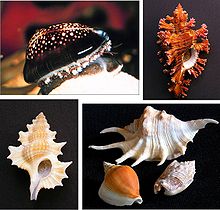新进腹足类
新进腹足类(学名:Caenogastropoda;caeno-,意思就是“新近”)是腹足纲之下的一个生物分类学演化支。旧作新生腹足总目,是最早由赖斯利·觉士于1960年提出,其中包含了很大数量海生腹足纲的种群,也包括少量在淡水及陆地生活的物种。新进腹足类由原来的中腹足目(Mesogastropoda)和新腹足目(Neogastropoda)组成,包含了腹足纲约60%的物种[3],例如:骨螺科、玉螺科等科,合计共约三万个物种。
| 新进腹足亚纲 化石时期:
| |
|---|---|

| |
| 多个新进腹足类物种 | |
| 科学分类 | |
| 界: | 动物界 Animalia |
| 门: | 软体动物门 Mollusca |
| 纲: | 腹足纲 Gastropoda |
| 演化支: | 直腹足类 Orthogastropoda |
| 演化支: | 后生腹足类 Apogastropoda |
| 亚纲: | 新进腹足亚纲 Caenogastropoda Cox, 1960[2] |
| 目 | |
生物学
编辑新进腹足类的外形表现身体扭曲成螺旋状,所以先前曾被归为扭神经亚纲(Streptoneura)和前鳃亚纲(Prosobranchia)。其特征包括,一个心耳和一对心叶,一个栉鳃,因此被更早的学者称为单心耳目(Monotocardia或Pectinobranchia)。
分类
编辑本分类最早由赖斯利·觉士于1960年提出,当时是一个总目[4]。 本类是从原来约翰尼斯·提艾利(Johannes Thiele)在1925年发表的分类方案里的中腹足目(Mesogastropoda)和新腹足目(Neogastropoda)合并组成[5],等同于Mörch在1865年发表的单心耳目。
根据齿舌的解剖学特征,本分类物种大致可以被分成两类:
- 带舌目Taenioglossa(taenio意思为带状),即后来的中腹足目Mesogastropoda,每行具有7个齿。
- 狭舌目Stenoglossa(stena意思为狭窄),即后来的新腹足目Neogastropoda,每行具有1-3个齿。
现时被作为一个不排序的支序去处理。基于系统分类学的优化分析,本支序确认为单系群[6]。
1997年分类
编辑旁得和林德伯格的腹足类分类 (1997年)及其他研究(例如:Vega et al., 2006[7];Harzhauser, 2004[8];及 Pina, 2002[9])均认同Cox(1960)的分类[4],认为新进腹足类是一个总目。在本分类中,新进腹足总目属于直腹足亚纲(Orthogastropoda)。
2005年分类
编辑在2005年出版的布歇特和洛克罗伊的腹足类分类,本类物种大致分为以下四大分支[5]:
- 新进腹足类的地位未定物种
- 主扭舌非正式群组 Architaenioglossa
- 吸螺支序 Sorbeoconcha
- 高腹足类支序 Hypsogastropoda:从吸螺目之下提升至跟吸螺目同级。
2017年分类
编辑在2017年出版的布歇特等人的腹足类分类,本类物种大致分为以下四大分支[10][11]:
- 主扭舌目(Architaenioglossa)
- 玉黍螺形目(Littorinimorpha)
- 新腹足目(Neogastropoda)
- 吸螺目(Sorbeoconcha Ponder & Lindberg, 1997):其范围从新修订过[12]。
- 然后其余内容都被归到新进腹足类的地位未定物种(暂时名称)
- 以下分类只有名称,不再有从属的分类单元:
- 高腹足总目(Hypsogastropoda)
- 异名
参考文献
编辑- ^ Ponder, W. F.; Colgan, D. J.; Healy, J.; Nützel, A.; Simone, L. R. L.; Strong, E. E. Caenogastropoda. Ponder, W. F. and Lindberg, D. L. (编). Phylogeny and Evolution of the Mollusca. Berkeley: U. California Press. 2008: 331–383. .
- ^ Cox L. R. (1960). In: Moore R. C. (ed.) Treatise on invertebrate paleontology. Part I., Mollusca 1, Gastropoda. The Geological Society of America, University of Kansas Press, Lawrence. xxiii + 351 pp., page 311.
- ^ Hayes, Kenneth A.; Cowie, Robert H.; Thiengo, Silvana C. A global phylogeny of apple snails: Gondwanan origin, generic relationships, and the influence of outgroup choice (Caenogastropoda: Ampullariidae). Biological Journal of the Linnean Society. 2009, 98: 61–76. doi:10.1111/j.1095-8312.2009.01246.x..
- ^ 4.0 4.1 Caenogastropoda. Paleobiology Database.
- ^ 5.0 5.1 Bouchet, P.; Rocroi, J.-P.; Frýda, J.; Hausdorf, B.; Ponder, W.; Valdés, Á. & Warén, A. Classification and nomenclator of gastropod families. Malacologia (Hackenheim, Germany: ConchBooks). 2005, 47 (1–2): 1–397. ISBN 3-925919-72-4. OCLC 61351079. OL 42989175M. S2CID 83847814.
- ^ Aktipis, Stephanie W.; Giribet, Gonzalo. A phylogeny of Vetigastropoda and other "archaeogastropods": Re-organizing old gastropod clades. Invertebrate Biology. 2010, 129 (3): 220–240. doi:10.1111/j.1744-7410.2010.00198.x.
- ^ F. J. Vega et al. El Espinal, a new plattenkalk facies locality from the Lower Cretaceous Sierra Madre Formation, Chiapas, southeastern Mexico. Revista Mexicana de Ciencias Geológicas. 2006, 23 (3): 323–333.
- ^ Harzhauser, M. Oligocene gastropod faunas for the Eastern Mediterranean (Mesohellenic Trough/Greece and Esfahan-Sirjan Basin/Central Iran). Courier Forschungsinstitut Senckenberg. 2004, 248: 93–181 (英语).
- ^ Pina, A. Caenogastropoda. [2013-08-20]. (原始内容存档于2012-08-03) (西班牙语).
- ^ Bouchet, P.; Rocroi, J.-P.; Hausdorf, B.; Kaim, A.; Kano, Y.; Nützel, A.; Parkhaev, P.; Schrödl, M.; Strong, E.E. Revised Classification, Nomenclator and Typification of Gastropod and Monoplacophoran Families. Malacologia. 2017, 61 (1–2): 1–526. OCLC 7296100651. S2CID 91051256. doi:10.4002/040.061.0201.
- ^ Bouchet, Philippe; Gofas, Serge; Wambiji, Nina. Caenogastropoda. WoRMS. 2013-01-17 [2018-04-13].
- ^ Gofas, Serge. Sorbeoconcha. WoRMS. 2010-06-02 [2017-02-26].
外部链接
编辑- Caenogastropoda. NCBI (英语).